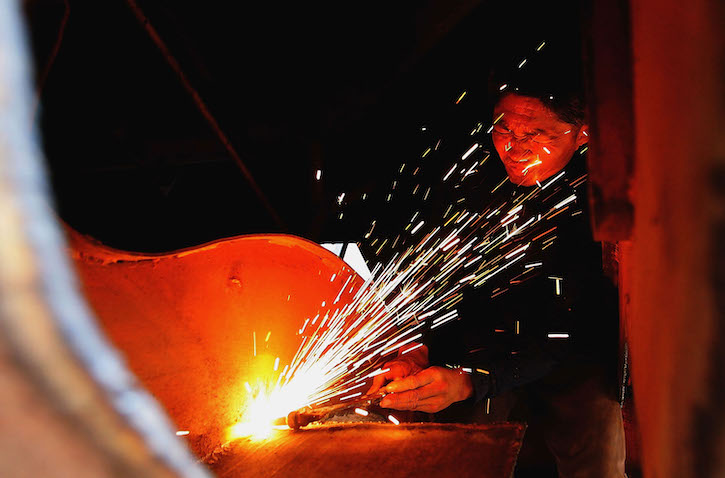
By Kate Gordon
As Wall Street backs away from coal projects, and some of the world’s largest coal companies file for bankruptcy, there seems little doubt that the era of Big Coal is coming to an end—leaving behind those workers and communities who have depended for over a century on coal mines and power plants for their livelihoods. The question of how to best help industrial communities transition to a more sustainable economic future is one that is top of mind here in the U.S., as is evidenced by the Obama administration’s recent “POWER” initiative, targeted at workforce and community development in coal-dependent communities. But it’s even more urgent in China, which is currently going through a major economic transition that risks leaving many workers out in the cold.
The long-anticipated 13th Five Year Plan, which was approved at last week’s National People’s Congress, contains some positive news for climate watchers: it caps total energy consumption and sets goals for carbon intensity; prioritizes renewable and efficient energy use (including through commitments to green financing); and emphasizes enforcement of existing air pollution regulations. All these commitments are in the broader context of China’s goal of shifting away from a heavy manufacturing-centric economy toward one that is more services-based. These are not small goals in a country whose economy is expected to double in size in from its 2010 levels in the next five years.
But the news is not all good for those who currently work in China’s high-emission industries like coal and steel, which are expected to lay off nearly 2 million workers in the next few years. As those sectors shrink to deal with overcapacity and carbon targets, the number may be as much as three times higher according to some government sources. Some have pointed out that this isn’t a huge number—it’s barely 1 percent of China’s overall workforce, after all—but the fact is that these are real people, with real jobs. To avoid significant unemployment and unrest, and to ensure that China actually has the workforce it needs to gear up a new, lower-carbon economy, a solid worker transition program is in order.
Chinese Premier Li Keqiang has committed to spend at least $15 billion—yes, that’s billion with a B—on worker retraining over the next two years. Less clear is how precisely these funds will be spent. During the last period of mass layoffs in China’s industrial sector (which, incidentally, were much bigger, with nearly 40 percent of all workers in the state-owned enterprise system laid off between 1995 and 2001), the government’s worker support mostly focused on shifting workers to the fast-growing private sector. It also helped that the private housing market was taking off at the same time, which in turn spurred a strong construction sector that also provided new jobs for blue-collar workers. Even then, according to one academic study, “Only a minority of displaced workers found new jobs; the rest either left the labor force or remained unemployed for many years.” This time the layoffs may be even more painful, because they come during an overall economic slowdown, with growth mainly in service sector industries that will likely require different skills and pay less than lost jobs in steel and coal.
As the world’s two largest and highest-emitting economies—that is, those countries with both the biggest incentive to transition to a cleaner economic model, and also those that potentially face the largest human impacts in doing so—the U.S. and China need to lead the way on worker transition as part of a broader low-carbon economic transition. Based on my own work on this issue over the past fifteen years, here are some broad recommendations for what China’s immediate transition plans should include (for those with appetites that go beyond 1000 words, these recommendations are spelled out in much greater detail in a 2009 Apollo Alliance white paper):
- Invest in retraining. The industrial economy and the service economy often have little in common when it comes to basic skills. China should not abandon its technically skilled workforce, but should invest in retraining these workers for more advanced manufacturing jobs in the new energy economy. These retraining programs should focus on training for skills in industries that are actually growing in the relevant region, and should involve industry leaders in those fields where possible.
- Put retraining programs in place quickly. The U.S. experience shows that providing workers with retraining opportunities at or even before the time layoffs occur can dramatically increase participation rates in these programs, as well as re-employment rates.
- Provide income replacement or early retirement programs for older workers. Older workers coming out of heavy industrial jobs may not be good candidates for retraining. In the U.S., large worker displacement programs such as the Trade Adjustment Act (TAA) provide extended income supports for workers over 60 to provide a bridge between layoff and retirement.
- Provide community and economic development support for heavily-affected communities. Job losses in mining and in geographically-concentrated industries like steel production don’t just affect workers—they affect the entire community surrounding these industries. The best worker transition programs include support for economic development in these areas. As China focuses on rebalancing its economy toward lower-carbon industries, economic development could prioritize investments in energy efficiency and renewable energy projects, for example.
- Provide environmental remediation for polluted industrial sites. Finally, as China ramps down its heavy industrial production and mining, it will need to work to remediate these often-toxic sites so they can be re-used for new development, or as parks or other green spaces.
China is just the latest, and likely the biggest, example of economic reshuffling leading to worker displacement. But given the government’s commitment to putting resources into worker transition, there’s a chance that China could get transition policy right—and in doing so, could provide a model to the rest of the world during the oncoming global energy transition.


